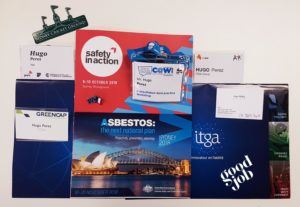According to an Asbestos Safety and Eradication Agency report, ‘on average, over the seven financial years from 2008 to 2014, Australians generated around 20kg of asbestos waste per capita‘, [1]. We assume that asbestos waste has been buried in suitable and regulated waste facilities.
In addition to the fact that asbestos waste infrastructures should be adequate for the foreseeable future, other French companies have developed innovative solutions that transform and recycle asbestos without any risks.
1. The vitrification
Since 1992, Inertam has provided an alternative solution to manage asbestos waste: the vitrification.
During this process, asbestos is heated in an oven until it reaches its point of fusion at around 1500°C (2700°F).
Melting at this temperature results in a complete fibres disintegrations and its intrinsic hazard. Then, the molten material, called Cofalit, is transferred to a refining chamber. Here, the Cofalit temperature is maintained while pushing out unmelted residues. Gases emitted during the melted steps extracted and treated through a gas treatment system.
The liquid Cofalit is sent to an open-air zone to chill while getting to its solid-state. Finally, this new material is crushed in order to be re-used in road sub-layer, without any risks [2].
![Recycling of asbestos waste: Cofalit [2]](https://media.licdn.com/dms/image/C4D12AQGUR1KMg_XvlQ/article-inline_image-shrink_1500_2232/0?e=1573084800&v=beta&t=2trgan_Zxo10ihHgdG3Pt0l8mr-8MtuYWbsMNd8cEmY)
This industrial process works 24h/7days and handles 30 tonnes of asbestos waste… A day.
For now, the only concern is about the price of the innovation: AUD 2000 per tonne to fully eliminate asbestos waste [3]. Is this economical barrier too high?
2. The Nevada process
The Nevada process came from a Corsica SME called Neutramiante [4] – ‘Amiante’ meaning asbestos in French.
This process implies a water and acid smart combination. Once sorted and crushed, asbestos waste is introduced in a reactor where it is mixed with acid and water.
![The Nevada process [4]](https://media.licdn.com/dms/image/C4D12AQFOO2f8NbJ0lw/article-inline_image-shrink_400_744/0?e=1573084800&v=beta&t=Aq8SuQ4D4px8jKUR1z-1HoTmU7tl1RXuSG3s4qYr3O8)
Then, the recipe is simple: On low heat, simmer for 6-8 hours and use a ‘flow divisor’ to separate liquid and solid. On one side, the magnesia salts from the obtained liquid are sold to magnesium metal producers. On the other side, the gypsum and the anhydrite are bought by the cement manufacturers to reduce their carbon dioxide emissions.
Finally, only the silica is left and re-used to produce zeolite, a swimming pool cleaner for air and water.
According to Dimension Amiante [5], the first industrial site will open this year.
By selling the primary and secondary products from the chemical reaction, Neutramiante generates a secondary source of incomes which enable the company to announce a competitive price: less than AUD 600 per tonne, which can compete with landfills.
The temperature of the process – 90°C – is much lower than the vitrification process which also justifies the price differential.
And what about the capacity? Paul Poggy, the director-owner, announced in Dimension Amiante, a capacity of 14,000 / 15,000 tonnes a year, almost 4% of the French tonnage.
Great perspectives to come in the asbestos waste management field!
Hugo PEREZ.
[1]: Dr Joe Pickin; Paul Randell, Final report, 22 September 2015, ‘Asbestos waste in Australia’, delivered by Asbestos Safety and Eradication Agency.
[2]: Inertam Groupe Europlasma, Asbestos processing and recycling, Inertam Groupe Europlasam, viewed 28 August 2019, <http://www.inertam.com/le-traitement-de-lamiante-sa-valorisation/?lang=en>.
[3]: Le Figaro, La vitrification de l’amiante, une solution ultime, Caroline de Malet, viewed 28 August 2019, <http://www.lefigaro.fr/sciences/2006/09/16/01008-20060916ARTFIG90596-la_vitrification_de_l_amiante_une_solution_ultime.php>.
[4]: Neutramiante, Ecological Solution for Neutralization and Valorisation of Asbestos, Neutramient, viewed 28 August 2019, <https://www.neutramiante.com/en>.
[5]: Christophe Demay, 2019, ‘Nevada ou l’alchimie de l’amiante’, Dimension Amiante,n°23, pp. 34-35.

![You are currently viewing [Article] Asbestos Waste: Recycle it is possible!](https://www.itgagroup.com/wp-content/uploads/2019/09/Vitrification.jpg)


